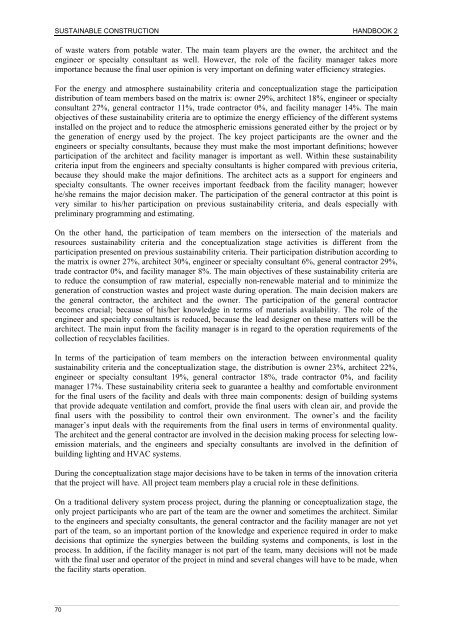Industrialised, Integrated, Intelligent sustainable Construction - I3con
Industrialised, Integrated, Intelligent sustainable Construction - I3con
Industrialised, Integrated, Intelligent sustainable Construction - I3con
You also want an ePaper? Increase the reach of your titles
YUMPU automatically turns print PDFs into web optimized ePapers that Google loves.
SUSTAINABLE CONSTRUCTION HANDBOOK 2<br />
of waste waters from potable water. The main team players are the owner, the architect and the<br />
engineer or specialty consultant as well. However, the role of the facility manager takes more<br />
importance because the final user opinion is very important on defining water efficiency strategies.<br />
For the energy and atmosphere sustainability criteria and conceptualization stage the participation<br />
distribution of team members based on the matrix is: owner 29%, architect 18%, engineer or specialty<br />
consultant 27%, general contractor 11%, trade contractor 0%, and facility manager 14%. The main<br />
objectives of these sustainability criteria are to optimize the energy efficiency of the different systems<br />
installed on the project and to reduce the atmospheric emissions generated either by the project or by<br />
the generation of energy used by the project. The key project participants are the owner and the<br />
engineers or specialty consultants, because they must make the most important definitions; however<br />
participation of the architect and facility manager is important as well. Within these sustainability<br />
criteria input from the engineers and specialty consultants is higher compared with previous criteria,<br />
because they should make the major definitions. The architect acts as a support for engineers and<br />
specialty consultants. The owner receives important feedback from the facility manager; however<br />
he/she remains the major decision maker. The participation of the general contractor at this point is<br />
very similar to his/her participation on previous sustainability criteria, and deals especially with<br />
preliminary programming and estimating.<br />
On the other hand, the participation of team members on the intersection of the materials and<br />
resources sustainability criteria and the conceptualization stage activities is different from the<br />
participation presented on previous sustainability criteria. Their participation distribution according to<br />
the matrix is owner 27%, architect 30%, engineer or specialty consultant 6%, general contractor 29%,<br />
trade contractor 0%, and facility manager 8%. The main objectives of these sustainability criteria are<br />
to reduce the consumption of raw material, especially non-renewable material and to minimize the<br />
generation of construction wastes and project waste during operation. The main decision makers are<br />
the general contractor, the architect and the owner. The participation of the general contractor<br />
becomes crucial; because of his/her knowledge in terms of materials availability. The role of the<br />
engineer and specialty consultants is reduced, because the lead designer on these matters will be the<br />
architect. The main input from the facility manager is in regard to the operation requirements of the<br />
collection of recyclables facilities.<br />
In terms of the participation of team members on the interaction between environmental quality<br />
sustainability criteria and the conceptualization stage, the distribution is owner 23%, architect 22%,<br />
engineer or specialty consultant 19%, general contractor 18%, trade contractor 0%, and facility<br />
manager 17%. These sustainability criteria seek to guarantee a healthy and comfortable environment<br />
for the final users of the facility and deals with three main components: design of building systems<br />
that provide adequate ventilation and comfort, provide the final users with clean air, and provide the<br />
final users with the possibility to control their own environment. The owner’s and the facility<br />
manager’s input deals with the requirements from the final users in terms of environmental quality.<br />
The architect and the general contractor are involved in the decision making process for selecting lowemission<br />
materials, and the engineers and specialty consultants are involved in the definition of<br />
building lighting and HVAC systems.<br />
During the conceptualization stage major decisions have to be taken in terms of the innovation criteria<br />
that the project will have. All project team members play a crucial role in these definitions.<br />
On a traditional delivery system process project, during the planning or conceptualization stage, the<br />
only project participants who are part of the team are the owner and sometimes the architect. Similar<br />
to the engineers and specialty consultants, the general contractor and the facility manager are not yet<br />
part of the team, so an important portion of the knowledge and experience required in order to make<br />
decisions that optimize the synergies between the building systems and components, is lost in the<br />
process. In addition, if the facility manager is not part of the team, many decisions will not be made<br />
with the final user and operator of the project in mind and several changes will have to be made, when<br />
the facility starts operation.<br />
70






